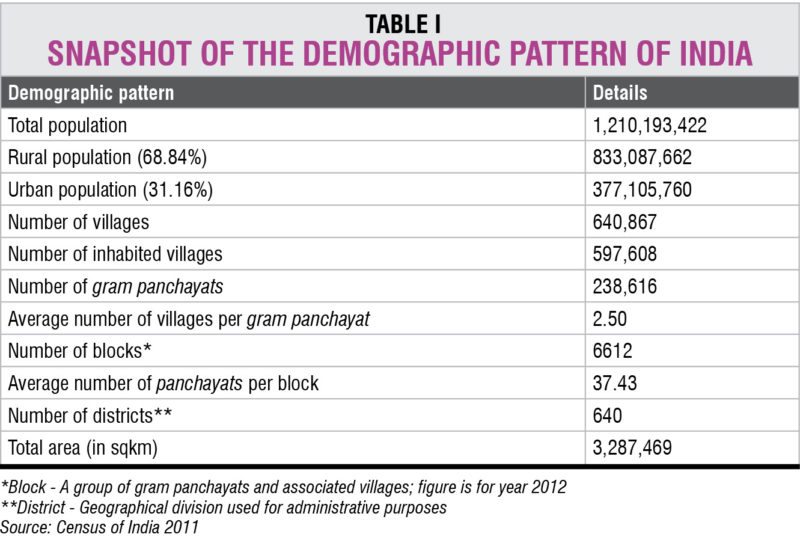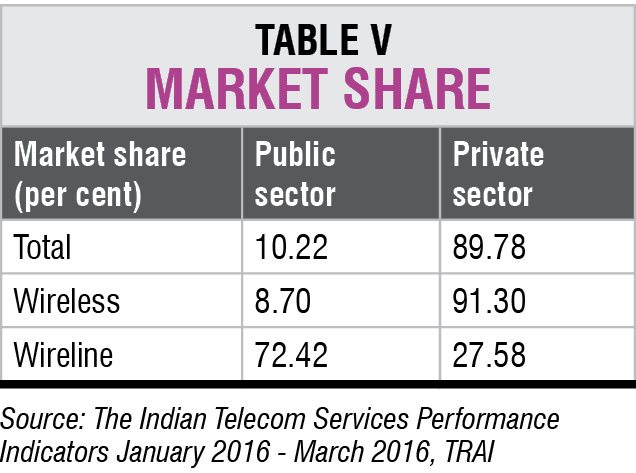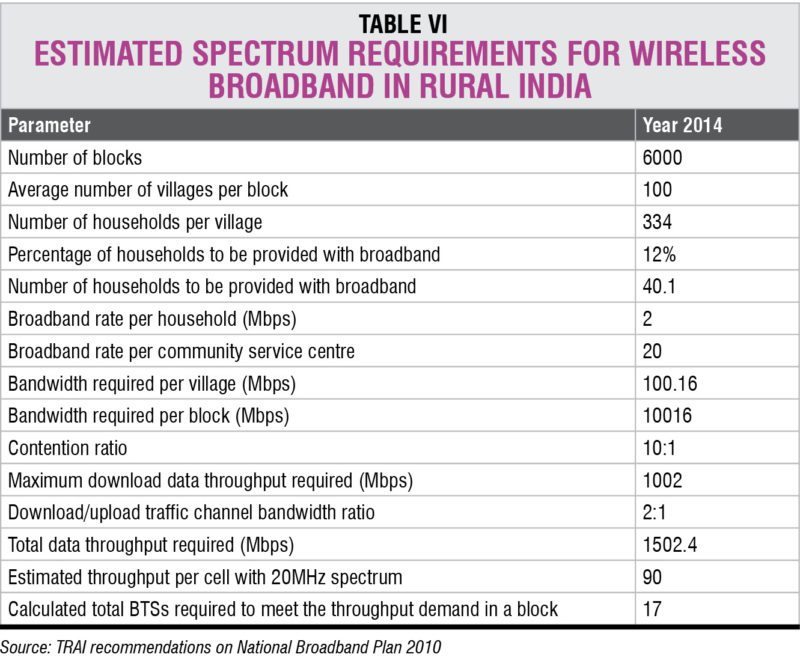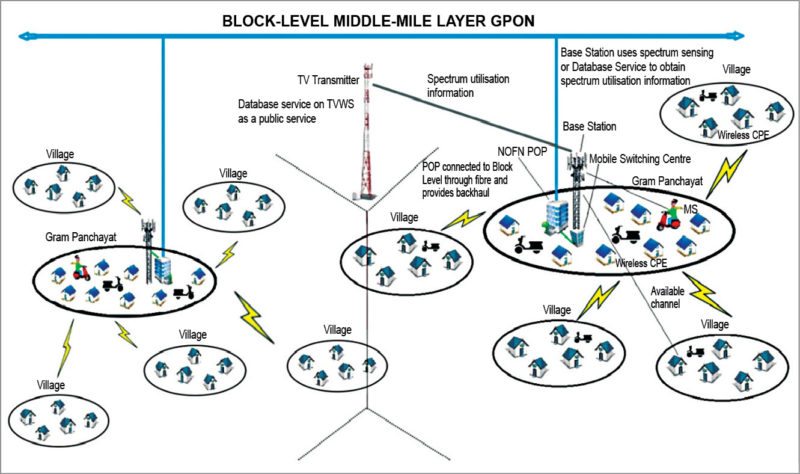Studies conducted by The World Bank show that there is a direct link between a country’s gross domestic product (GDP) and broadband penetration. On an average, a ten percentage-point increase in broadband penetration results in a 1.38 percentage-point increase in the GDP of a developing country. Further, studies involving 33 Organisation for Economic Cooperation and Development (OECD) countries show that doubling the broadband speed increases the GDP by 0.3 per cent.
In India, the facilities and conveniences offered by broadband Internet and mobile connectivity have not reached rural pockets, where approximately 70 per cent of the population lives, because telecom network operators do not find it economically viable to do business there. This is due to low population density and high cost of initial investment.
The Indian government has initiated projects to take fibre connectivity till the gram panchayat level; a gram panchayat being the lowest local self-governing administrative body that governs a group of villages. This still leaves the last-mile connectivity unaddressed.
Providing last-mile connectivity using wired means is not cost-effective—low population density, difficult terrain and insurgency being key factors. Hence, there is a strong need to create wireless broadband technology solutions that can cover large and thinly-populated areas in a cost-efficient manner that businesses find economically-viable and scalable.
Broadband in the Indian context
Countries define broadband differently and revise the definition as technology advances. As per Telecom Regulatory Authority of India (TRAI), the body that advises the Indian government on policies related to telecommunications, broadband is defined as “A data connection using any technology that is able to support interactive services including Internet access and support a minimum download speed of 512 kilobits per second (kbps).”
TRAI further recommends “that the upload speed will at least be half the download speed. This definition of broadband (both wireline and wireless) is effective from January 1, 2011. The stipulated download speed of 2Mbps will be effective from January 1, 2015.”
While International Telecommunications Union (ITU) classifies broadband as fixed versus mobile, TRAI has merged the definitions of wireline and wireless broadband and included services and speed in its definition on the advice of various stakeholders as well as examining trends in broadband technologies and policies of several countries such as the USA, Germany and Japan.
TV band spectrum and cognitive radio for broadband
There is an increasing urgency to provide broadband Internet services to rural and underserved communities, both from an economic and social perspective. One of the biggest challenges in providing wireless last-mile connectivity to rural India is cost of spectrum.
Radio spectrum is owned by the government and is auctioned to network operators who prefer to offer services in urban areas. Hence, additional radio bands have to be identified. Since spectrum is allocated in bands, statically and exclusively, to various services on a long-term basis, it has led to most of the spectrum being assigned, leaving very little for additional services.

This prompted the research community to look closely at spectrum utilisation to find out temporal and spatial efficiency of utilisation, leading to the emergence of the term white space. White space refers to those parts of the licensed spectrum that are not used by the network operator all the time or at all geographical locations.
A band observed to contain generous amounts of white spaces was the TV band, and this was called TV white space (TVWS). TV band spectrum occupies VHF and UHF range and hence has radio propagation properties that make it attractive for communications. VHF/UHF signals travel over longer distances for a given transmission power compared to higher-frequency signals. Thus, large areas can be covered using economical medium-sized antennae.
It has been estimated that to obtain a 100sqkm coverage area using UHF, ten cells are required. This is four times fewer than that needed in 2.4GHz band (43 cells) and 12 times fewer in 5.8GHz band (121 cells). Most countries, including India, are moving from analogue to digital TV transmission, leading to vacating large bands of TV spectrum.
TV band spectrum also has guard bands between channels that, though not contiguous, can be used for wireless communications. The unused TV band spectrum may be utilised in the following manner:
Unlicensed. In the same manner as ISM and Wi-Fi bands, but does not address the rural connectivity problem
Auctioning the spectrum. Generates revenue for governments but discourages rural private participation
Unlicensed but controlled access to spectrum. Needs additional technologies to minimise interference to licensed users
In order to guarantee quality of service and spectrum availability to licensed primary users of the spectrum, unlicensed users who first have to identify and occupy unused frequency bands also have to vacate as soon as primary users return. The domain of cognitive radio tackles this through channel sensing and, of late, through geo-location databases that store real-time information about channel availability and usage.
Cognitive radio refers to a device that is aware of its radio environment such as spectrum availability, signal strength, channel access methods, transmission protocols and spectrum policy, and is capable of opportunistically choosing the right parameters to participate in radio communication. From the cognitive radio perspective, spectrum spaces are categorised into white space (totally unoccupied), gray space (partially occupied) and black space (fully occupied).

Accordingly, three techniques are used: interweaving, underlaying and overlaying. Interweaving refers to sensing the spectrum to identify unused bands and utilising the same for transmission. Underlaying refers to transmitting information at low power levels so as to not cause interference to licensed primary users. Overlaying refers to using part of the transmitting power to enhance occupied signal levels, thus increasing the probability of signal detection by licensed users. Simultaneously, information is transmitted at low power levels with other cognitive users.
Need for broadband connectivity in rural India
As per the census of India 2011, around 69 per cent of the people live in rural areas in approximately 600,000 villages (Table I). Villages can have wide population ranges with over 50 per cent having population between 1000 and 5000 (Table II).The following observations give broad indications of the social-economic state of rural India:
1. Only 32 per cent of grade III students in government-run schools can read grade I textbooks
2. 31 per cent of rural population travels more than 30km to seek healthcare
3. 61 per cent of rural population remains unbanked
4. 41 per cent of farmers require vital agricultural information on a daily basis
5. 59 per cent of childbirth deliveries are not conducted in hospitals and 51 per cent are not safely done
6. 68.6 per cent of trafficked women and children are from rural India
7. Rural population’s lack of online trading skills and poor technology infrastructure prevents them from taking advantage of e-commerce and m-commerce to market locally-produced goods such as handicrafts. According to eBay India, of the 4306 e-commerce hubs in the country, only 1015 hubs are rural hubs (http://shopping.ebay.in/census/index.php)
These problems can be addressed through large-scale deployment of connected services such as telemedicine, e-agriculture, online learning, mobile banking, e-commerce and e-governance, all of which pre-suppose the availability of affordable broadband connectivity.
Existing telecom connectivity scenario in rural India
The rural telecom connectivity scenario can be looked at in terms of its subscriber base, infrastructure and Internet usage.
Subscriber base. According to Department of Telecommunications (DoT) memo, as of August 2016, the country had 1053.86 million telephone connections of which there were 447.36 million (42 per cent) connections in rural areas and 606.50 million (58 per cent) in urban regions. Overall tele-density (number of telephones per 100 people) stands at 82.57 per cent with rural tele-density at 51 per cent and urban at 152 per cent.
Of the existing telephone connections, 97.7 per cent (1029.35 million) were wireless and only 2.3 per cent (24.51 million) were wireline. The corresponding wireline figure in August 2015 was 26.01 million, showing a yearly decline of 5.77 per cent.
In March 2016, the number of wireline subscribers was 25.22 million, of which, 4.32 million (17.13 per cent) were rural subscribers. The number of wireless subscribers was 1033.63 million, of which 444.84 million (43 per cent) were rural subscribers. Although the wireless percentages do not show much urban-rural disparity, the rural tele-density figures (51 per cent) are poor compared to urban (152 per cent).


Infrastructure. Village public telephones (VPTs), a primary means of voice communication, have been provided in 98.12 per cent villages as of December 2015. VPTs are expected to be provided in remaining villages through Universal Service Obligation Fund (USOF), a financial corpus lying with the government and generated by annual contribution of a percentage of revenue earned by telecom companies.
To increase rural tele-density through wireless means, a plan to build 7353 mobile towers to provide services to uncovered villages (cluster of villages) having a population of 2000 or more was initiated. As of December 2012, 7310 towers (99.42 per cent) were set up and 16,023 base transceiver stations were commissioned, according to DoT’s annual report of 2012-2013.
 Despite efforts to provide infrastructure, most rural areas have only 2G coverage. Mobile subscriptions that come bundled with Internet connectivity do not have speeds comparable to broadband. Key constraints cited in providing 3G are aggregation and backhaul. This is echoed in Mbit Index by Nokia Solutions and Networks, which shows that although 3G in India grew by 146 per cent year-on-year basis in 2014, the growth is limited to cities.
Despite efforts to provide infrastructure, most rural areas have only 2G coverage. Mobile subscriptions that come bundled with Internet connectivity do not have speeds comparable to broadband. Key constraints cited in providing 3G are aggregation and backhaul. This is echoed in Mbit Index by Nokia Solutions and Networks, which shows that although 3G in India grew by 146 per cent year-on-year basis in 2014, the growth is limited to cities.
Internet usage. A snapshot of Internet subscriber connectivity is given in Tables III and IV. Once again, rural subscriber density (subscribers/100 population) is half the total and one-fourth the urban density.
Almost 40 per cent of rural Internet users used community service centres and cyber cafes to access the Internet in 2013. The figure was 71 per cent in 2009; the fall is perhaps due to the growth in mobile tele-density. A large number, almost 54 per cent, reported having to travel a distance of more than 10km to access the Internet.
As regards the purpose of accessing the Internet, email was the preferred application (85 per cent), followed by music and video (67 per cent), education information search (48 per cent), general information search (42 per cent) and text chat (40 per cent). Data also shows that around 84 per cent rural Indians stated not being aware of the Internet as the main reason for not using it.

Plans to take broadband to rural India
In August 2010, the Indian government prepared a white paper highlighting the importance of democratising information, especially government information, as lack of timely access to information leads to imbalance in power equations and, hence, exploitation of information have-nots. It suggested that government services such as birth and death certificates, land records, police reports, court papers and the like should be provided to the 250,000 gram panchayats using broadband connectivity via a reliable fibre-optic network. To achieve this, the report recommended the creation of a special-purpose vehicle, funded by USOF, to lay a fibre network till gram panchayat level.
Bandwidth estimate provided by TRAI in December 2010 shows a minimum of 2Mbps to 4Mbps for acceptable quality of service for common applications like email and Internet browsing. Other applications such as telemedicine and multimedia based distance learning requiring higher bandwidths are to be provided selectively. Table VI shows the estimated spectrum requirements for year 2014.
In 2012, the Indian government formulated National Telecom Policy (NTP) 2012 that envisaged an “empowered and inclusive knowledge based society using telecommunications as a platform.” The policy stated that the country has to achieve Broadband on Demand. A key objective was to reposition the mobile phone as a multifunction gadget so that it can serve as proof of identity, Internet banking device, training device and so on.
The 12th Five Year Plan (2012-2017) identifies the challenges in realising the vision of Broadband on Demand for rural and remote areas. To introduce 3G/4G/LTE/BWA services, it said that high-speed network infrastructure is essential and, hence, government intervention is required to provide incentives for roll-out in rural areas, investment in technology to bring down prices of smartphones, investment in R&D for efficient spectrum utilisation and, most importantly, periodically review spectrum allocation to release unutilised spectrum. Based on the above, a nation-wide network, called National Optical Fibre Network (NOFN), funded by USOF, was planned to provide high-speed broadband to all gram panchayats. A special purpose vehicle, Bharat Broadband Network Ltd (BBNL), was created to set up and operate the network. Bandwidth will be provided to all eligible service providers in a non-discriminatory manner to deliver important services such as e-skilling and e-health.
BBNL plans to use existing fibre connectivity of three government-owned units, namely, BSNL, Railtel and Power Grid, for providing backhaul and laying the remaining cabling.
BBNL has completed pilot projects covering 58 gram panchayats in three states, namely, Rajasthan, Andhra Pradesh and Tripura. Only 5000 gram panchayats have been connected. The original 2013 deadline for connecting all gram panchayats was revised to March 2017and later advanced to December 2016.
In the meanwhile, a committee was formed to review NOFN project and provide recommendations. It gave its recommendations in March 2015. It has identified the causes for delay of NOFN project, some key reasons being linear architecture followed in laying cables, which will not provide acceptable reliability as expected by service providers, lack of alternatives in cases of difficult and hostile terrain, deficiencies in project management and inadequate planning with regards to how the network will be utilised.
The committee has extended the scope of NOFN keeping the objectives of Digital India in mind and renamed the project BharatNet. Apart from connecting gram panchayats, BharatNet is expected to provide a minimum 2Mbps bandwidth to all rural households on-demand, and on-demand capacity to all institutions on a non-discriminatory basis. It is expected to do this by 2017. Recommendations have been submitted to the government of India and approval is awaited.
To provide online government services, National e-Governance Plan was formulated by the government’s Department of Electronics and Information Technology (DeitY). As of March 2014, 133,847 common services centres (CSCs)—a core infrastructure component—have been set up at gram panchayats. Scope of CSCs is being broadened to provide services such as e-education and telemedicine by a village-level entrepreneur.
The Indian government introduced Digital India programme in 2014, to be managed by DeitY. Key focus areas of the programme are:
1. Digital infrastructure to all citizens, including access to high-speed broadband, cradle-to-grave digital identity and bank account
2. Governance and services on demand
3. Digital empowerment of citizens, the first initiative of which is visible on http://mygov.nic.in
In August 2014, the Indian government launched a financial inclusion scheme, Jan-Dhan Yojana (www.pmjdy.gov.in), wherein banks have been directed to open 75,000,000 zero-balance bank accounts along with a debit card for Internet banking by January 2015 in rural and underserved areas. This target has been far exceeded with around 215,100,000 accounts being opened along with a Rs. 366,000 million as total account balance.
To minimise misuse, all government schemes are linked to biometric based 12-digit unique identification numbers called Aadhaar provided to each citizen including infants. The unique identity creation and assignment is managed by Unique Identification Authority of India (http://uidai.gov.in). A little over 1000 million IDs have been issued as of April 2016 covering practically every citizen of the country.
The above initiatives coupled with the rural connectivity scenario indicate that, if rural initiatives have to have their desired impact, then broadband connectivity affordable to rural citizens and economically viable to service providers is a must.
How India is utilising the TV band spectrum
In India, frequency bands are allotted to various wireless services as per National Frequency Allocation Plan (NFAP) 2011, which also provides for future applications such as digital terrestrial broadcasting services, for example, digital TVs, mobile TVs and the like.
The only national terrestrial TV broadcasting service in India, known as Doordarshan, is provided by the government. Only two of the five national programmes of Doordarshan, namely, DD National and DD News, are broadcast throughout India using two channels called DD-I and DD-II via 1416 high-power transmitters.
DD-I is also used to broadcast regional programmes on a time-sharing basis. As each channel is of 8MHz, only 16MHz bandwidth would be in use at any given time and location.
There is a plan to switch from analogue to digital terrestrial TV transmission, and band allocation to digital broadcasting services including mobile TVs is 585MHz – 698MHz as per NFAP 2011. Studies undertaken to experimentally determine and quantify the availability of TVWS across the country, taking into consideration the pollution and protection viewpoints, show that TV band spectrum is severely underutilised with an average TVWS availability of more than 100MHz, which is sufficient to provide affordable broadband in rural India.
A model for rural broadband connectivity
A proposed system model to connect villages by utilising NOFN point of presence at each gram panchayat connected to the block level through fibre, and providing last-mile wireless connectivity through CR using TVWS, is illustrated in the figure (right). Every gram panchayat or a cluster of gram panchayats in geographical proximity can share the infrastructure facility for broadband communication through the mobile switching centre (MSC) using NOFN backhaul.
The proposed model requires the MSC to sense or utilise geo-location database service to receive available spectrum information. A multi-user channel-allocation protocol is required to support fair spectrum allocation to neighboring gram panchayats and also among end users under a gram panchayat. The micro-cell concept and the co-existence strategy between primary and secondary users are the key enabling factors in this model.
Challenges in implementing CR-TVWS in India
In order to formulate policies on TVWS, the Indian government will have to act on plans for complete switchover from analogue to digital terrestrial TV broadcasting and set a time frame. A policy needs to be framed to support harmonious co-existence between TVWS users with incumbent TV broadcasting with a guaranteed quality of service for both.
The socio-economic consequences of allocating TVWS using various options such as unlicensed, auction, controlled, licensed shared access (LSA), authorised shared access (ASA), etc have to be carefully evaluated.

For usage of white spaces in licensed bands such as GSM, telecom companies need to be taken into confidence as free and unlicensed access to run mobile networks might give an unfair competitive edge to users of white spaces.
Standards for communications in CRN have to be laid down; transmitting power of customer premises equipment, mobile equipment and base stations in the secondary network will have to be laid down to avoid harmful interference to incumbents’ network. IEEE 802.22 WRAN (wireless regional area network) standard is defined for accessing licensed TV-band channels by secondary users on a non-interference basis.
WRAN standard has to be tested in the Indian context. Global ICT Standardisation Forum for India (GISFI) (www.gisfi.org) has a special working group on spectrum to study TVWS and its utilisation in India. However, there has been no update on the website since June 2012.
Rules need to be formulated to protect other sensitive networks such as military, radio astronomy and healthcare services operating in the same band. A detailed guideline is required on allocation, responsibilities and operation of geo-location database services.
There is no database service in the country as of now. It will have to be set up in cooperation with government agencies throughout the country after identifying indigenous constraints.
Policies to grant licences to use the TV band spectrum to run experimental networks need to be framed. Data regarding TV bands used in each region in the country is required so that interference levels can be checked. There is no easily-available data regarding location of TV transmitters in the country.
Adequate funding needs to be allocated to set up experimental test-beds to conduct research experiments by academia. Mechanisms for tie-ups with private and government telecom players to set up and test real networks in different terrains in rural India on experimental basis to support crucial initiatives such as Internet banking and telemedicine and identify issues, especially related to security, specific to regions are essential for successful deployment of CRN.
In addition to the challenges depicted above, successful deployment of CRN requires well-planned and coordinated functioning of multiple layers of communications. However, technical aspects of communication are beyond the scope of this article and hence not discussed.
Meera S. Datta is PhD scholar, electronics and communications engineering, working as faculty advisor at NIIT University
Dr Sushanta Das is former research guide, NIIT University. He is currently working with Hyundai America Technical Centre, USA








